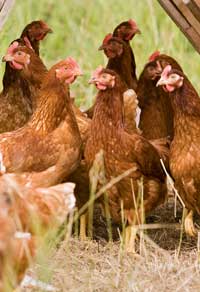ADAS offers tips on getting hens to range more

This year has seen both the Lion Code and Freedom Food raise the external stocking density to 2000 birds/ha over the life of the flock.
And as free-range egg producers take advantage of the increase, range management will become more crucial in maintaining cover and encouraging birds to use the whole area.
Speaking at a recent DEFRA-funded seminar, ADAS consultant and animal behaviour specialist Heleen van de Weerd said that good ranging doesn’t just bring health and welfare benefits, it had environmental benefits, too.
“If hens stay near the shed, you can get high nutrient loading near the house. In addition, there is the PR image of the industry with hens outside in fields.”
Flock size
Looking at the factors that encourage ranging, she started with flock size.
Smaller flocks tend to have a greater proportion of birds outside. She highlighted figures from one project which found 40% of birds ranging in small flocks of less than 500 birds. However, larger flocks of more than 1500 hens had only 5% ranging.
“The key message is the larger the flock, the harder you need to work to get them outside.”
She highlighted another study where researchers found that even in a small 500-bird flock, 8% never left the house during the six-month trial period.
“This is because hens are able to discriminate between different individuals within their own social group. They seem to prefer to associate with familiar rather than strange individuals or groups of hens,” she said.
Rearing age
Another factor is the bird’s experience of the outside environment during rear, increasing its readiness to use the range as an adult. There is good experience in the organic sector that giving birds early access from six weeks of age helps encourage ranging.
She suggested either letting young birds outside early or giving birds a flavour of the outside by putting mesh on the pop holes and opening them. Birds can then experience sunlight, outdoor sounds, smells and views.
Weather
An obvious factor affecting whether birds venture outside is the weather. “You get least ranging in winter (wind and rain) and in bright (hot) sunshine. The optimum temperature is 15-20C.”
Range cover
This is where cover comes in, as it gives birds shelter from the wind, direct sun and rain. It can either be natural cover, such as trees, hedges, crops, herbs and grass or artificial structures.
One of the requirements of the increased stocking density by Freedom Food is that natural cover should account for 5% of the total range area.
With grass, Dr van de Weerd suggested having a short, hard wearing grass mixture near the house where traffic is highest. “Further away, you can provide a longer, more nutritious grass.”
With hedges, she suggested planting them in rows away from houses as birds use them as corridors. But you will need to protect them during establishment and may need annual pruning.
Artificial structures also have a valuable role in drawing out birds. “The variation and quality of artificial structures is more important than the number of shelter per se.”
Examples include homemade shelters made from sheets of roofing on wooden posts through to old articulated lorries. “They need to offer shelter while being robust and movable.”
Around popholes
A crucial area to manage is around the pop holes, where heavy traffic can lead to bare soil and puddling. Again, Freedom Food is requiring producers opting for the higher stocking density to pay further attention to this area of the range.
Andrew Watts of Fridays highlighted that poor management can have a direct economic impact on producers, through greater numbers of dirty eggs resulting from muddy hens feet.
He outlined how his producers use beach pebbles around the pop holes to help keep birds feet clean and avoid puddling.
“We are fortunate to be near the coast and are able to import several loads of stone costing about £800. It is well worth it.”
Producers replenish the beach area each year. It has proved valuable, as the units are situated on heavy, Kent Weald clay.
Plastic netting is also an option for maintaining grass cover near sheds, said Alison Wintrip, also from ADAS. “Grass grows through while the netting prevents birds from digging up the soil.”
The seminars organised by ADAS were funded by DEFRA with additional support by the British Free Range Egg Producers Association.
Nutrients from the range
It’s not surprising that hens naturally forage for additional nutrients, being descended from the Jungle Fowl whose natural habitat was dappled forest.
One study highlighted by ADAS’ Heleen van de Weerd on feral birds in a forest found that birds scratched for feed in the humus under trees. Birds consumed slugs, different insects, berries and seeds.
Separate Danish research showed that the actual intake from the range can be significant. Birds consumed 10-30g/hen/day of a grass clover ley and that this accounted to about 70% of their lysine and methionine requirements. “These are the most important amino acids for birds.”
So by getting the range right, producers can boost the intake of additional feed sources such as grass, weeds, seeds, beetle, spiders, earthworms and caterpillars. “It allows individual hens to supplement their diet with nutrients they need and may even help cut feed costs.”
